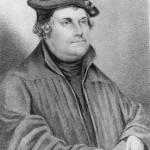 At the Ligonier blog, Steven Lawson the one God first used to spark a transformation of Christianity and the Western world. He was the undisputed leader of the German Reformation. In a day of ecclesiastical corruptions and apostasies, he was a valiant champion of the truth; his powerful preaching and pen helped to restore the pure gospel. More books have been written about him than any other man of history except Jesus Christ and possibly Augustine.
At the Ligonier blog, Steven Lawson the one God first used to spark a transformation of Christianity and the Western world. He was the undisputed leader of the German Reformation. In a day of ecclesiastical corruptions and apostasies, he was a valiant champion of the truth; his powerful preaching and pen helped to restore the pure gospel. More books have been written about him than any other man of history except Jesus Christ and possibly Augustine.
Luther came from hard-working stock. He was born in the little town of Eisleben, Germany, on November 10, 1483. His father, Hans, was a copper miner who eventually gained some wealth from a shared interest in mines, smelters, and other business ventures. His mother was pious but religiously superstitious. Luther was raised under the strict disciplines of the Roman Catholic Church and was groomed by his industrious father to be a successful lawyer. To this end, he pursued an education at Eisenach (1498–1501) and then at the University of Erfurt in philosophy. At the latter, he received a bachelor of arts degree in 1502 and a master of arts degree in 1505.
Luther’s life took an unexpected turn in July 1505, when he was twenty-one. He was caught in a severe thunderstorm and knocked to the ground by a nearby lightning strike. Terrified, he cried out to the Catholic patroness of miners, “Help me, St. Anna, and I will become a monk.” Luther survived the storm and made good on his dramatic vow. Two weeks later, he entered the Augustinian monastery in Erfurt. His father was furious over Luther’s apparent wasted education, but Luther was determined to follow through on his vow.
Lost in Self-Righteousness
In the monastery, Luther was driven to find acceptance with God through works. He wrote: “I tortured myself with prayer, fasting, vigils and freezing; the frost alone might have killed me… . What else did I seek by doing this but God, who was supposed to note my strict observance of the monastic order and my austere life? I constantly walked in a dream and lived in real idolatry, for I did not believe in Christ: I regarded Him only as a severe and terrible Judge portrayed as seated on a rainbow” (Luther’s Works, Vol. 24, eds. Jaroslav Jan Pelikan, Hilton C. Oswald, and Helmut T. Lehmann [St. Louis: Concordia, 2002], 62). Elsewhere he recalled: “When I was a monk, I wearied myself greatly for almost fifteen years with the daily sacrifice, tortured myself with fastings, vigils, prayers, and other very rigorous works. I earnestly thought to acquire righteousness by my works” (Luther’s Works, Vol. 12, 273).
In 1507, Luther was ordained to the priesthood. When he celebrated his first Mass, as he held the bread and cup for the first time, he was so awestruck at the thought of transubstantiation that he almost fainted. “I was utterly stupefied and terror-stricken,” he confessed. “I thought to myself, “Who am I that I should lift up mine eyes or raise my hands to the divine majesty? For I am dust and ashes and full of sin, and I am speaking to the living, eternal and true God’” (Luther, cited in Bruce Shelley, Church History in Plain Language [Nashville: Thomas Nelson, 1995], 238). Fear only compounded his personal struggle for acceptance with God. Continue reading
